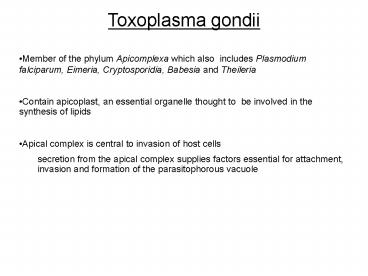Toxoplasma gondii - PowerPoint PPT Presentation
1 / 27
Title:
Toxoplasma gondii
Description:
Contain apicoplast, an essential organelle thought to be ... My-Hang Huynh, Vern B. Carruthers. PLoS Pathogens August 2006, Vol. 2 Issue 8, pp 0753-0762 ... – PowerPoint PPT presentation
Number of Views:2102
Avg rating:3.0/5.0
Title: Toxoplasma gondii
1
- Toxoplasma gondii
- Member of the phylum Apicomplexa which also
includes Plasmodium falciparum, Eimeria,
Cryptosporidia, Babesia and Theileria - Contain apicoplast, an essential organelle
thought to be involved in the synthesis of
lipids - Apical complex is central to invasion of host
cells - secretion from the apical complex supplies
factors essential for attachment, invasion and
formation of the parasitophorous vacuole
2
Toxoplasma Gondii Life Cycle Review
Tachyzoites rapidly divide and invade neighboring
cells
Micro and macro gametes form (gametogenesis)
Gametes fuse to form oocyst
Excystation occurs and sporozoites released
Bradyzoites eventually sequestered in muscular
tissue cysts
Merizoites invade neighboring cells
Oocyst ingested by intermidiate host
Parasites multiply in inetestinal cells
Sporulation occurs
Bradyzoite ingested
Bradyzoites may exit cyst at random
3
(No Transcript)
4
(No Transcript)
5
Toxoplasma MIC2 is a Major Determinant of
Invasion and Virulence My-Hang Huynh, Vern B.
Carruthers PLoS Pathogens August 2006, Vol. 2
Issue 8, pp 0753-0762
6
Purpose To address the role of MIC2 in Toxplama
gondii Synopsis Generated a conditional MIC2
knockout mutant using a tetracycline regulatable
system. Show that MIC2-deficient parasites are
severely impaired in their ability to attach to
and invade host cells and are non-lethal in vivo.
7
- MICs
- Micronemal proteins
- MIC2 is a transmembrane adhesin thought to play a
role in gliding motility and cell invasion - Contains several extracellular adhesive domains
for receptor binding and a short cytosolic
domain that connnects it to the glydosome - Member of the TRAP (thrombospondin-related
anonymous protein) family - MIC1 assembles with MIC4 and MIC6, soluble
proteins in micronemes - MIC3 involved in host cell binding
8
- Conditional Knockout System
- Transcriptional transactivator (tTA)
- Genes containing the operator cassettes are
upstream of the transcription start site of gene
of interest - Genes are constitutively transcribed until
addition of tetracycline - tTA released from operator cassette preventing
further transcription
9
- Strains and Constructs
- tTA-dhfr reference strain containing inducible
marker - mic2i inducible MIC2 construct (transfected on
episome) - mic2e/mic2i has inducible and endogenous MIC2
- ?mic2e/mic2i endogenous MIC2 knocked out via
homolgous recombination
10
Supplementary Figure 1
11
(No Transcript)
12
(No Transcript)
13
(No Transcript)
14
Relationship with M2AP MIC2 and M2AP intimately
associate soon after synthesis Absence of M2AP
causes mislocalization and reduced secretion of
MIC2 Underexpression of MIC2 abolishes
proteolytic maturation of M2AP from proform to
mature form
15
Relationship with M2AP
16
Red-Green Invasion Assay ExtracellularRed Intrace
llularGreen
17
Correlation of number of invaded parasites with
expression and secretion of MIC2
Conclusion Absence of MIC2 causes, for one,
defect in attachment to host
18
Time-Course Invasion Over 8 Hours
19
Deletion of MIC2 has no effect on parasite
replication
20
(No Transcript)
21
Gliding Trails and Tribulations
22
Quantification of Gliding Motions
C
Circular GlideRed arrow Helical GlideRed
arrowhead Nonproductiveclosed black Twirlingopen
black
23
Cytoskeletal Analysis
No difference in number of helical and straight
cytoskeletons
24
Infectivity Studies
25
Quantitative Real Time PCR to Monitor Parasite
Burden in Different Tissues
Dead by day 10
Infection cleared by day 15
26
Cytokine Levels
27
Conclusions Dramatic reduction in MIC2
production does not affect parasite replication
and has no effect on circular gliding
motions Extreme reduction of MIC2 causes
impairment in host attachment and decreases
helical and twirling motions ?mic2 parasites are
unable to establish an infection in mice up to
625X the normal lethal dose and can protect
against challenge with wild type































